Garage shelves make it possible to place tools, car parts, consumables and other things in the room. To make shelving in the garage, it is important to decide on the material, take measurements, choose a design and outline a drawing of the structure.
Benefits of homemade shelving
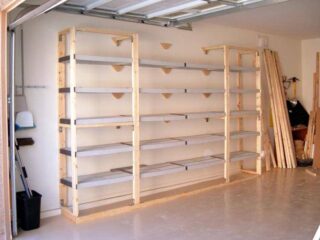
A do-it-yourself garage rack has a number of advantages. The main thing is the ability to develop a unique design. Standard shelves are less attractive. The manufacturing process does not take much time. The shelves can be designed to your liking.
There is an option for a garage arrangement with ready-made systems with a simple fastening mechanism. But it is not always possible to decide on the dimensions of the shelves. In addition, purchased products have a low level of functionality.
Homemade shelving has a number of advantages:
- saving space;
- ease of storage of tools;
- giving the garage room a well-groomed look;
- elimination of clutter;
- ease of assembly and disassembly.
Depending on the pace of assembly, the rack can be:
- Stationary. The structure is designed for a specific place in the room. Attached to the wall with brackets.
- Mobile. There is a possibility of rearrangement. The rack has wheels and a trolley. It is important to control the load by avoiding loading the shelves.
- Collapsible. The height and position of the shelves changes.
- Suspended. Mounting is carried out to walls or ceilings anywhere. The structure can be rotated. The structure is not designed for storing large instruments.
An important component is the size of the rack. The larger the shelf, the more spacious it is. When planning the size and number of components in a product, it is important to proceed from the area and height of the garage room.
Materials used
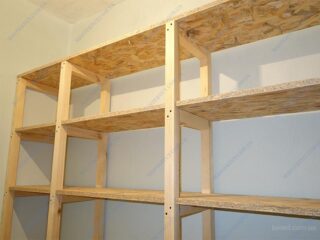
The most common shelving materials are wood, plastic and iron. Sometimes combined structures are assembled.
Wood is an affordable and easy-to-process material. The cost is low, working with it does not require any special skill. The material endures increased loads, since it is more elastic than metal.
The main disadvantage of a wooden rack is its short service life. Over time, the material dries and rots, which is provoked by a sharp drop in temperature and humidity. It is possible to extend the service life of the structure by applying a special agent or choosing durable wood species. The material can be replaced with chipboard, which is also susceptible to decay and is highly flammable.
The second most popular is the metal profile. Usually steel or aluminum is used. The first variety is strong and durable. The downside is the large weight and complexity of processing. The aluminum construction is lightweight, but not as strong as steel. Under heavy load, the profile is subject to deflection.
In order to save money, many resort to PVC-based rack assembly. But this design is intended to store only light items.
The budget option is a combined model based on metal and PVC.It is more durable. Suitable for storing small items. You can combine metal and wood. Racks for shelving are often made of shaped steel pipe. The shelves themselves are assembled from boards.
The best option is plastic structures. The material can carry up to 75 kg. The advantage of the product is its low weight, portability and ease of maintenance. Of the shortcomings, fragility should be noted. The material is easily damaged by mechanical stress. Not suitable for storing metal tools.
Which shelving is better: welded or bolted
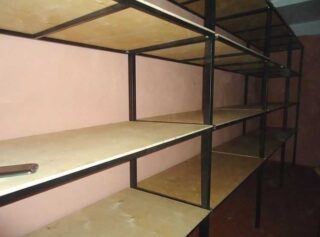
The shelves in the garage are made on the basis of metal and wood. Most of the latter designs are not understandable. Fastened on the basis of nails or self-tapping screws. Installed permanently to the wall.
Welded metal structures cannot be disassembled. There are iron devices on connections by means of bolts. They are distinguished by their mobility, they can sort it out if necessary. The disadvantage of the design is the low level of rigidity, since there is a backlash in the joint. For stability, the racks are fixed to the wall. For this purpose, metal plates with a hole into which the crutch is driven are welded to the extreme posts.
Welded structures are more often made. The collapsible option is resorted to in two cases: transfer to another room and the impossibility of using welding.
Designs and dimensions
The structure includes uprights, crossbars and shelves. In order to increase the rigidity on the rear side, fasteners are mounted, the basis of which is made up of steel strips. They are screwed or welded diagonally to the end posts. Provides side load compensation for increased stability and strength.
Shelf heights and depths are freely selectable. The choice of the span length is important - the distance between the posts in one section.
An important indicator is the rigidity of the material. The shelves should not bend under heavy load. For heavy items, the span should be 1.5 meters. With a light load, the indicator can be increased to 2 meters.
When installing a rack of greater length, racks are mounted in the gaps, the distance between which should be no more than 2 meters. The lowest shelf should be 50–70 cm above floor level. Usually heavy objects are placed on it. The rest of the components are located at different heights. The optimal distance is 35-37 cm.
Before starting work, measurements are taken, and a diagram of the future design is made. The rack should not be bulky. Compact size saves space.
Tools required for the job
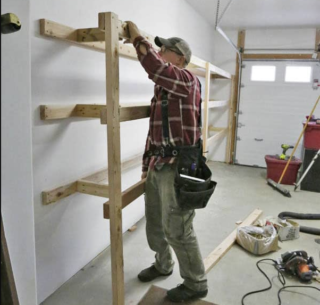
The independent process of making shelves involves the preparation of improvised tools.
In the course of work, the master will need:
- set of wrenches;
- pliers;
- hacksaw for wood;
- welding machine;
- drill;
- combined grinder;
- a hammer;
- screwdriver;
- puncher;
- electric jigsaw;
- Bulgarian.
At the preparatory stage and during the installation process, measuring devices are used - a tape measure and a level. Fixation of products is carried out by means of anchor brackets or dowels.
Manufacturing process of metal shelves
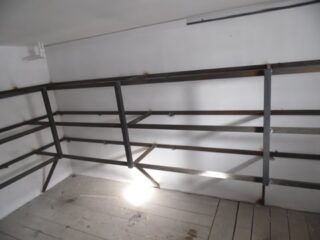
It is possible to make a metal structure from rectangular pipes or professional pipes with an indicator of the width of one of the sides of 5 cm. For the manufacture of crossbars, a 30-mm corner is used. The frame is made from a corner with the expectation that the thickness of the shelf will be 1.5-3 cm.
The crossbeams based on the corners are welded to the vertical guides. Bolting is a smart solution. This manufacturing option allows you to change the height of the shelves. When using a corner, the connection can be overlapped. The difference of 3-5 mm when stacking the shelves remains unnoticeable.
Cutting corners for a smooth connection
Creating a bolted structure involves separately assembling the squares of the sidewalls and shelves and then twisting the parts. Each connection is secured with two bolts. If the basis of the racks is formed by shaped pipes, the sidewalls are initially assembled, and then the crossbars are attached. The result is two rectangles with crossbars. In some cases, they resort to welding.
There is another method of fastening by means of special crab systems. They represent metal plates with grooves formed under the profile. Pipes are laid in the grooves, then two elements are tightened with bolts. Such a connection does not withstand heavy loads.
The advantage of the device is the absence of holes on the metal surface. M6 and M8 bolts are used. They require large holes. Initially, they are drilled with a thin drill, then the hole is expanded to the desired size with a thick drill.
Making a simple structure out of wood
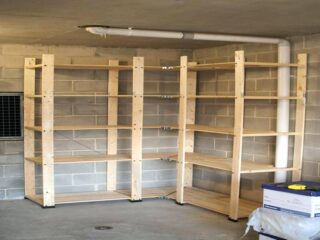
Oak and other hardwoods are ideal materials. Pine can be used. Vertical posts are made of a hoop with a cross-sectional index of 10x10 cm or 10x5 cm. A less wide beam or board is used as crossbars. Shelves in accordance with the size are cut from a chipboard sheet.
In order to extend the service life and reduce the risk of fire, the boards should be treated with a special antiseptic solution before assembly.
With vertical marking of the racks, the attachment points of the shelves are marked. A wooden rack in the garage is assembled by means of self-tapping screws, spikes and glue. The best option for a strong connection is metal-based needles. After assembly, the product is varnished. The ends are pre-processed.
How to mount shelving in a garage
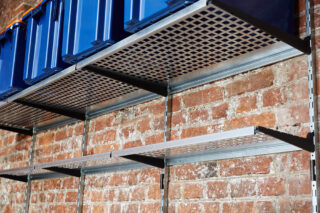
An important point is the type and number of wall mounts. Usually they resort to using dowels.
The shelves on the wall in the garage can be attached directly. It is supposed to drill a hole in one of the posts and screw the screw into the dowel through it. The method is reliable, but inconvenient to implement. It is usually used when assembling a structure from a metal profile.
Fastening with angles involves the use of steel parts. It is less durable and requires a large number of screws and dowels. It is used when assembling a structure made of wood. Working with corners is easy. The number of points where the shelves are attached to the wall affects the strength level. The more often the fasteners are located, the higher the strength of the structure. In this case, more work is required.








